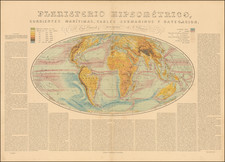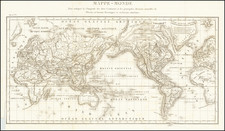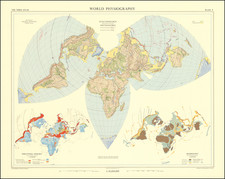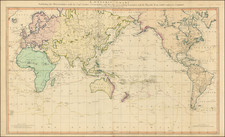One of the Earliest Thematic Maps -- The First Thematic Map Focused on Zoology
Map of the world showing the distribution of mammals or quadrupeds. As noted by Princeton's on-line exhibition on Thematic Mapping, Zimmerman's map is the:
first map of animal geography. . . It is the addition and geographical placement of the Latin names of quadrupeds that distinguishes the map from anything previously published. Castor (beaver), for example, appears throughout northern North America; leo (lion) in Africa; and kanguro (kangaroo) in northeastern Australia, where Cook's men first sighted one. Though very rudimentary in style and accuracy, the map marks an auspicious moment in the history of thematic mapping.
Zimmerman was one of the pioneers of "Biogeography." As noted in Origins of Biogeography, the true genius of Zimmerman's work is how he managed to meld natural histories and travelogues. Rather than producing a detailed systematic catalogue of different types of quadrupeds, Zimmerman produced a classification of where they are found.
When it was published, Specimen Zoologicase Geographicae was the only work that categorized the planet into known quadruped distributions . . .
. . . Zimmerman published Tabula mundi geographico zoologica sistens quadrupedes hucusque notos sedibus suis adscriptos (Zimmerman, 1777), possibly the first distributional map that gave certain Linnaean names and the distributions.
There appears to be at least 2 versions of this map, drawn from different copper plates. The John Carter Brown Library holds a copy with 2 columns of text to the left of the cartouche and 4 columns to the right, which on closer inspection are letterpress sheets pasted onto the map, bearing the imprint of "T Haas & Soc" Lugo Batarorum" and is dated by the JCB at 1777.
The present example would seem to have updated and improved cartographic features and more likely dates to the decade after the last of James Cook's Voyages, and bears the imprint "Joseph Marianus Sculp. Aug. Vind ." A copy of this map is found in the National Library of Australia.
Eberhard August Wilhelm von Zimmermann (1743-1815) was a German philosopher, biologist and geographer. He studied at the University of Leiden, Halle and Goettingen. He travelled a lot in Europe. One of his big publications was Taschenbuch der Reisen, 12 annual editions ( Leipzig 1802-1813).
http://libweb5.princeton.edu/visual_materials/maps/websites/thematic-maps/quantitative/natural-history/natural-history.html









![De Schepping der Wereldt Volgens de Beschryving van Mozes. 1 Plaat [in set with] De Schepping der Wereldt Volgens de Beschryving van Mozes. 2. Plaat](https://storage.googleapis.com/raremaps/img/small/102641.jpg)

![Hemisphere Septentrional du Globe Terrestre Veu en concave l'oeil estant au Pole AntArctique . . . 1696 [and] Hemisphere Superieur du Globe Terreste pour l'Horizon de Paris Veu en convexe l'oeil etant pose au zenith et a distance infinie du plan de projection . . . 1697](https://storage.googleapis.com/raremaps/img/small/85541.jpg)


